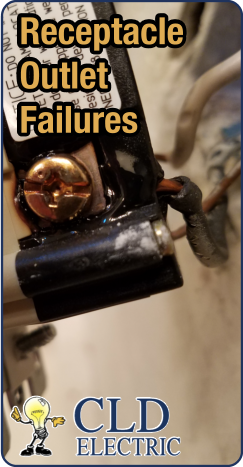
During my 25-year occupation as an electrician, I have replaced many receptacles in both the residential and industrial production sectors. Here I am going to briefly share with you some of the common causes of outlet failure and what to keep an eye out to help elongate the lifespan of your electrical system.
The first item and maybe the most overlooked contributor to the receptacle and eventual system failure is over-amping. Over-amping is when an appliance that carries a larger amperage demand than the receptacle can carry is utilized. An excellent example of this would be using a 1200 watt space heater on a 15amp standard room circuit that has other electrical loads plugged in tandem or generally searing the same circuit. The 15 amp circuit is designed to carry 12amp continuously (under 3 hours), and prolonged exposure to higher amperage will eventually cause failures either at the outlet or down the line at other points along the feeder due to excessive heat. Over-amping is a relatively easy thing to avoid by keeping an eye on the size and number of appliances you plug into a circuit, and if you need to use a big appliance, have a circuit installed for it to prevent the overload.
The next and perhaps a more sinister cause of receptacle outlet failure is the loose connection. The loose connection can happen in a multitude of ways, starting with a novices’ improper installation. When the assembler under-torques the screw lugs or uses the push clip wire connectors on the backside of the device, it is only a matter of time before the connection is lost and the system safety is at risk of over amperage due to increased circuit resistance. Another way connections can lose contact is through system vibration. The electrical system we use here in America is driven by a 60 Hurtz wavelength that reverses the electrical flow 60 times per second. This frequency puts a minimal but constant strain on the system, and since most receptacles get used as daisy-chained connection points, this is where we see the most damage.
The last cause of failure I am going to touch on is simple age. As the system gets used throughout the years, it will inevitably get worn by the user and by nature’s elements. Plastics break down in the sun, the metal components get destroyed by moisture in the air, and we use the same receptacles year after year without noticing the connection losing its grip. It is essential to understand that the loss of a good electrical connection is the reason for failure here.
In conclusion, a good rule of thumb to keep your electrical system healthy, avoid costly repairs, and prevent possible hazards, is to replace the receptacles when either they start to feel loose or every 30 to 40 years as a precaution whichever comes first. Remember to avoid over amping the system by getting that circuit when and where you need it and always have a trained and CA State Certified Electrician install your electrical components.
By Jerry Herron CEO of CLD Electric
